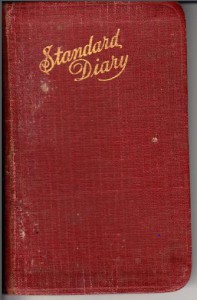 If your family is anything like mine, you heard plenty of stories about your great-grandparents from your parents. From those stories I have been able to get a sense of their personalities and how they lived, but it is a view limited to how my parents knew them as their grandparents. Learning who your ancestors were as young adults is difficult, since most standard documents do not reveal an individual’s personality. My mother has a genealogical file on each of my relatives, where she keeps news clippings or other documents pertaining to their lives, which I often refer to while I am researching my family. During my last visit home, while searching through her files, I discovered the diary of my great-grandmother, Gladys Tompkins, from the year 1924.
If your family is anything like mine, you heard plenty of stories about your great-grandparents from your parents. From those stories I have been able to get a sense of their personalities and how they lived, but it is a view limited to how my parents knew them as their grandparents. Learning who your ancestors were as young adults is difficult, since most standard documents do not reveal an individual’s personality. My mother has a genealogical file on each of my relatives, where she keeps news clippings or other documents pertaining to their lives, which I often refer to while I am researching my family. During my last visit home, while searching through her files, I discovered the diary of my great-grandmother, Gladys Tompkins, from the year 1924.
Diaries such as this one, which have just small spaces to write in each day, provide a window into the diarist’s important activities, since there is not enough space to write about much more. Many of Gladys’ daily entries were limited to “we washed today” or “we did not do much today.” Short as they are, her entries reveal much about the cycle of social life in rural New York. Many of her entries in the winter note that she felt lonesome, while the entries in the spring and summer are filled with visits and dances. Her entry for Monday, 11 February 1924, reads “We washed today. It is quite cold. Am sleepy and lonesome. Wish it were June. Haha.” These are moments where her personality shines through, providing a glimpse of who she was and how she felt at the age of twenty.
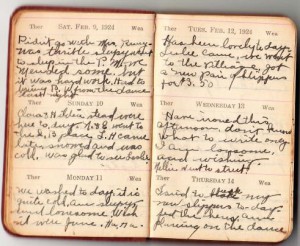 Her entries also provide important information about her friends and relatives, as she mentions her visitors. I was especially excited to find this diary, because 1924 was the year that my great-grandparents Gladys Tompkins and Leslie Holdridge were married. I had hoped the diary would chronicle their engagement and the preparations for their wedding, but the only indication of their relationship was a number of entries noting “L.H. came today” or “I hope Leslie visits.” On 18 October, the day of their wedding, the entry was simple. She even started the entry with “we finished packing today,” followed by “Leslie and I went to Prattsville this P.M. We were married there in the M.E. Church.” She also noted that Charlie and Olive accompanied them, but there is little other information about the wedding, suggesting that it was small and intimate.
Her entries also provide important information about her friends and relatives, as she mentions her visitors. I was especially excited to find this diary, because 1924 was the year that my great-grandparents Gladys Tompkins and Leslie Holdridge were married. I had hoped the diary would chronicle their engagement and the preparations for their wedding, but the only indication of their relationship was a number of entries noting “L.H. came today” or “I hope Leslie visits.” On 18 October, the day of their wedding, the entry was simple. She even started the entry with “we finished packing today,” followed by “Leslie and I went to Prattsville this P.M. We were married there in the M.E. Church.” She also noted that Charlie and Olive accompanied them, but there is little other information about the wedding, suggesting that it was small and intimate.
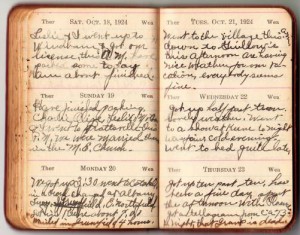 While I was fascinated reading about my great-grandmother’s daily life in 1924 and her budding relationship with my great-grandfather, I knew that the best genealogical information was likely to be in the back of the book, where there are spaces for addresses and notes. There was one page that recorded all the letters she received that year and when she replied. This information is valuable, since you cannot always discern who individuals were closely associated with by looking at vital and census records alone. Gladys also recorded her grandmother’s birthdate and age in 1924, as well as the birthdates of some of her friends.
While I was fascinated reading about my great-grandmother’s daily life in 1924 and her budding relationship with my great-grandfather, I knew that the best genealogical information was likely to be in the back of the book, where there are spaces for addresses and notes. There was one page that recorded all the letters she received that year and when she replied. This information is valuable, since you cannot always discern who individuals were closely associated with by looking at vital and census records alone. Gladys also recorded her grandmother’s birthdate and age in 1924, as well as the birthdates of some of her friends.
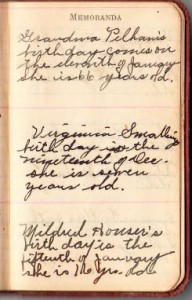 Perhaps the most intriguing and unexpected page in the back was a list of names entitled “attended our horning.” Having never heard of a “horning” before, a little research revealed that it was a wedding ritual where friends of the bride and groom would blow horns outside the couple’s bedroom window on their wedding night. According to Nancy Grey Osterud, author of Bonds of Community: The Lives of Farm Women in Nineteenth-Century New York, a horning ritual was just as important to most couples as their wedding ceremony and they would have been sorely disappointed if they did not receive one. In contrast to their small and quiet ceremony, the horning was a rowdy and fun-loving affair, and it was clearly important enough to Gladys for her to record all the names of those in attendance.
Perhaps the most intriguing and unexpected page in the back was a list of names entitled “attended our horning.” Having never heard of a “horning” before, a little research revealed that it was a wedding ritual where friends of the bride and groom would blow horns outside the couple’s bedroom window on their wedding night. According to Nancy Grey Osterud, author of Bonds of Community: The Lives of Farm Women in Nineteenth-Century New York, a horning ritual was just as important to most couples as their wedding ceremony and they would have been sorely disappointed if they did not receive one. In contrast to their small and quiet ceremony, the horning was a rowdy and fun-loving affair, and it was clearly important enough to Gladys for her to record all the names of those in attendance.
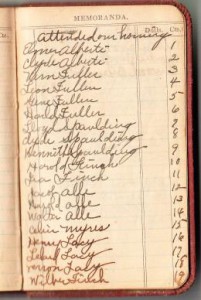 If you are lucky enough to come across daily journals of your ancestors while researching your family, you may be surprised at how much information you can gather from a few sentences recorded each day. Always be sure to check the pages hidden in the back, as they may contain names, birthdates, and anniversaries, or maybe even references to a horning.
If you are lucky enough to come across daily journals of your ancestors while researching your family, you may be surprised at how much information you can gather from a few sentences recorded each day. Always be sure to check the pages hidden in the back, as they may contain names, birthdates, and anniversaries, or maybe even references to a horning.
Share this:
About Meaghan E.H. Siekman
Meaghan holds a Ph.D. in history from Arizona State University where her focus was public history and American Indian history. She earned her B.A. in history from Union College in Schenectady, New York, the city where she grew up. Prior to joining the NEHGS team, Meaghan worked as the Curator of the Fairbanks House in Dedham, Massachusetts, as an archivist at the Heard Museum Library in Phoenix, Arizona, and wrote a number of National Register Nominations and Cultural Landscape Inventories for the National Park Service. Meaghan is passionate about connecting people with the past in meaningful and lasting ways. She enjoys finding interesting anecdotes about an ancestor to help bring the past to life.View all posts by Meaghan E.H. Siekman →